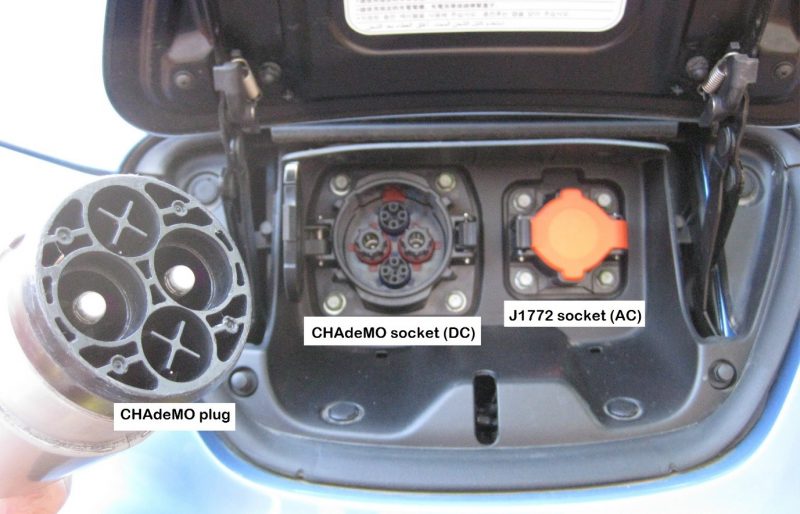CCS (Combined Charging System) one of several competing charging plug (and vehicle communication) standards for DC fast charging. (DC fast-charging is also referred to as Mode 4 charging – see FAQ on charging Modes).
Competitors to CCS for DC charging are CHAdeMO, Tesla (two types: US/Japan and rest of world) and the Chinese GB/T system. (See table 1 below).
Competitors to CHAdeMO for DC charging are CCS1 & 2 (Combined Charging System), Tesla (two types: US/Japan and rest of world) and the Chinese GB/T system.
CHAdeMO stands for CHArge de MOde, and was developed in 2010 by a collaboration of Japanese EV manufacturers.
CHAdeMO is currently capable of delivering up to 62.5 kW (500 V DC at a maximum of 125 A), with plans to increase this to 400kW. However all installed CHAdeMO chargers are 50kW or less at the time of writing.
For early EVs such as the Nissan Leaf and Mitsubishi iMiEV, a full charge using CHAdeMO DC charging could be achieved in less than 30 minutes.
However for the current crop of EVs with much larger batteries, a maximum 50kW charging rate is no longer adequate for achieving true ‘fast-charge’. (The Tesla supercharger system is capable of charging at more than twice this rate at 120kW, and the CCS DC system is now capable of up to seven times the current 50kW speed of CHAdeMO charging).
This is also why the CCS system allows for a much smaller plug that the older separate CHAdeMO and AC sockets – CHAdeMO uses a totally different communications system to Type 1 or 2 AC charging – in fact it uses many more pins to do the same thing – hence the large size of the CHAdeMO plug/socket combination plus the need for a separate AC socket.
It is worth noting that to initiate and control charging, CHAdeMO uses the CAN communications system. This is the common vehicle communication standard, thus making it potentially compatible with the Chinese GB/T DC standard (with which the CHAdeMO association is currently in talks to produce a common standard) but incompatible with the CCS charging systems without special adaptors that are not readily available.
Table 1: Comparison of major AC and DC charging sockets (excluding Tesla)I realise that a CCS2 plug will not fit the socket on my Renault ZOE due to there being no space for the DC part of the plug. Would it be possible to use the Type 2 cable that came with the car to connect the AC part of the CCS2 plug to the Zoe’s Type2 socket, or is there some other incompatibility that would stop this working?
The other 4 are simply not connected when DC charging(See Pic 3). Consequently, when DC charging there is no AC available to the car via the plug.
Therefore a CCS2 DC charger is useless to an AC-only electric vehicle.In CCS charging, the AC connectors use the same system for ‘talking’ to the car and the charger2 as is used for the DC charging communications.One communications signal (via the ‘PP’ pin) tells the EVSE that an EV is plugged in. A second communications signal (via the ‘CP’ pin) tells the car exactly what current the EVSE can supply.
Commonly, for AC EVSEs, the charge rate for one phase is 3.6 or 7.2kW, or three phase at 11 or 22kW – but many other options are possible depending on the EVSE settings.
As shown in Pic 3, this means that for DC charging the manufacturer only needs to add and connect two more pins for DC below the Type 2 inlet socket – thereby creating the CCS2 socket – and talk to the car and EVSE via the same pins as before. (Unless you are Tesla – but that is a longer story told elsewhere.)
Post time: May-02-2021







